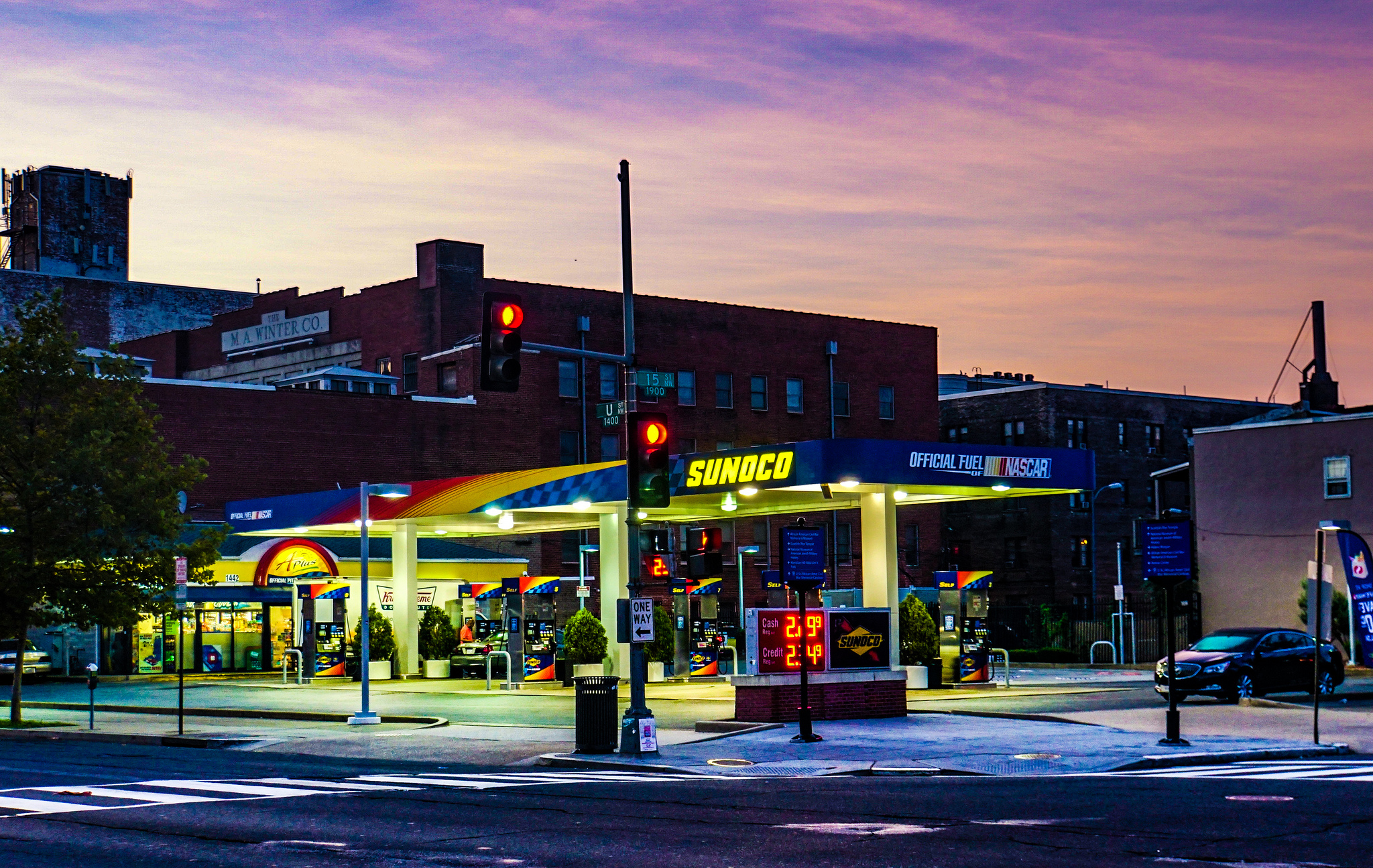Manufacturing facilities, department stores and car dealerships all employ sizable numbers of workers in many parts of the country. But in the District of Columbia, they’re not so common. These and other types of industries are underrepresented locally, providing fewer jobs given the size of the economy than most other places.
D.C.’s economy is unique in that it, of course, relies heavily on government as a major source of employment. It’s mostly urban as well, so one wouldn’t find as many establishments here more prevalent in suburbs. The sectors of the District’s economy also reflect its demographics.
Using data from the Labor Department, we’ve identified larger industries that are among the least concentrated in D.C. relative to the rest of the country. A measure reported in the Quarterly Census of Employment and Wages, the location quotient, compares the concentration of an industry locally to that of the entire national economy. A location quotient of 1 represents an industry with the same shares of jobs, while a location quotient of 0.5 means that the local concentration is half that of the U.S. economy.
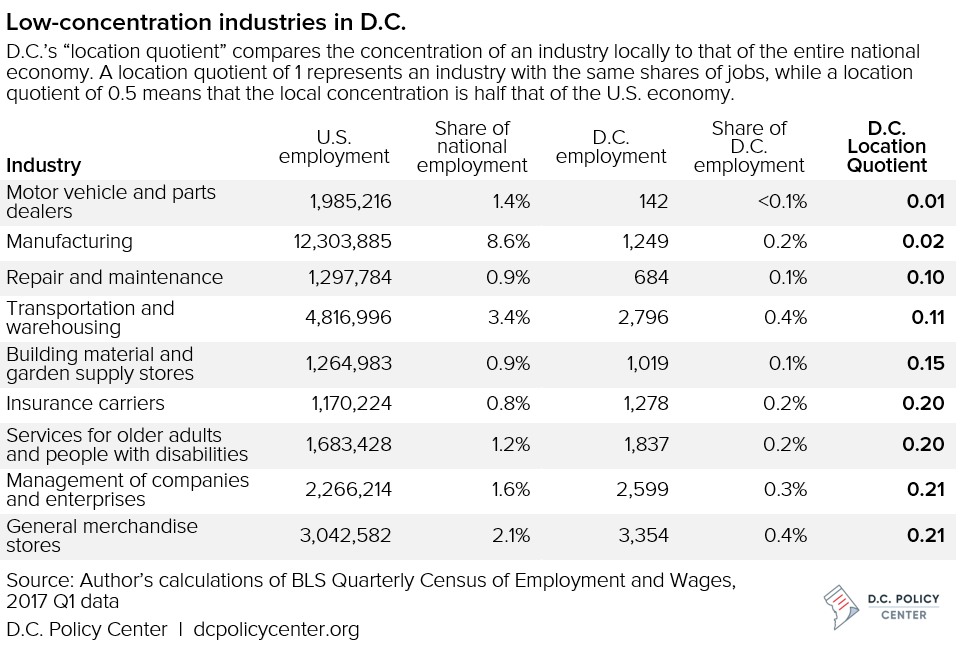

When compared with neighboring jurisdictions, there are some stark differences. D.C.’s lack of general merchandise stores and motor vehicle-related establishments is much greater than what’s seen in Arlington, Fairfax, Montgomery, Prince George’s and Prince William counties. That’s to be expected, given that those jurisdictions are generally more suburban.
One industry that’s particularly absent in the District is private sector transportation and warehousing. Federal estimates suggest these jobs account for less than one-half of a percent of jobs, while industry shares in the city of Baltimore (4.3 percent), Arlington (4.8 percent) and Prince George’s County (3 percent) are much higher. Jobs in management of companies and enterprises are also significantly less concentrated in D.C. than its surrounding counties and Baltimore. Meanwhile, manufacturing sector employment and services for the elderly and disabled are both low not only for D.C., but for the region as a whole compared with national levels.
The most underrepresented industries in D.C.’s economy
The following private sector industries employing more than a million workers nationally recorded among the lowest location quotients in the District as of March 2017.[1]
Motor vehicle and parts dealers
Location Quotient: 0.01
With public transportation, walking and biking, D.C. residents don’t rely on cars to get around as much as other places. This, too, is reflected in the lack of car dealerships locally. Motor vehicle and parts dealers employed just 142 workers in D.C., according to federal estimates.
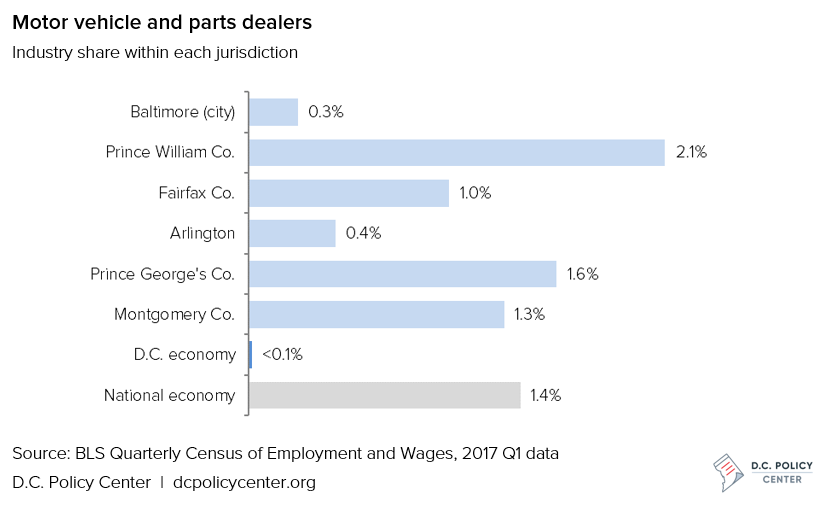

Nearly 2 million employees work in the industry nationwide, meaning they’re particularly underrepresented in D.C. The few such jobs that do exist in the District mostly consist of auto parts stores and several smaller used car dealers. Another likely contributing factor to D.C.’s low tally is its high real estate costs given that dealerships need large lots.
Motor vehicle and parts dealers are much less common in D.C. compared to surrounding jurisdictions. They’re most prevalent in suburban Prince William County, Va., and Prince George’s County, Md.
(These figures don’t include wholesalers, reported separately.)
Manufacturing
Location Quotient: 0.02
Manufacturing jobs are extremely sparse throughout D.C. Only about 1,200 workers were employed in the entire sector in March. The industry’s presence in the District is about 50 times lower than that of the national economy, the biggest discrepancy of any major sector. All segments of manufacturing are underrepresented, with very low location quotients reported for industry subsets including chemical manufacturing (0.02), apparel manufacturing (0.04) and fabricated metal product manufacturing (0.01). Most of the few manufacturing-related jobs here are tied to food manufacturing, notably bakeries and breweries.
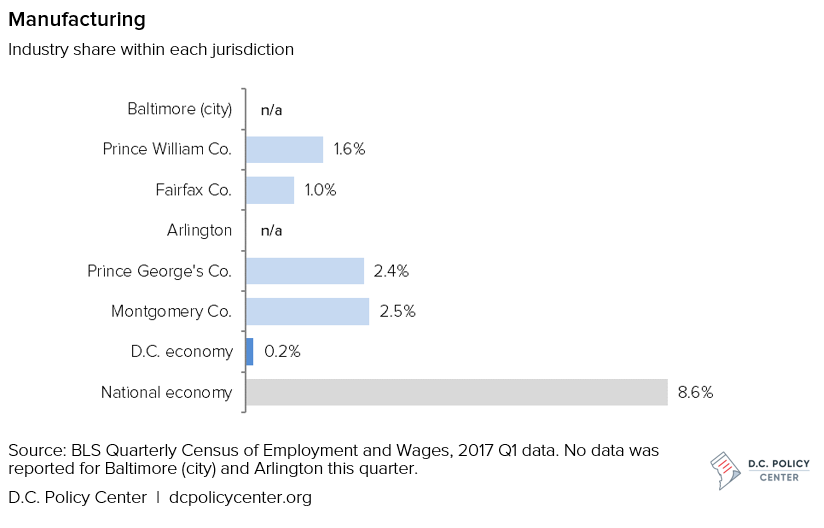

While D.C.’s concentration of manufacturing employment is low, jobs in the industry are generally uncommon across the region. The sector makes up nearly 9 percent of total U.S. employment. In Montgomery County, which reported the highest concentration locally, the share is a mere 2.5 percent. The counties surrounding the District only employ a few thousand such workers each.
Repair and maintenance
Location quotient: 0.10
There’s no shortage of repair and maintenance-related work in D.C. But it’s likely that most of these companies and their employees are based in the metro area outside of the District, as other counties have concentrations of repair and maintenance workers closer to the national average (see below).
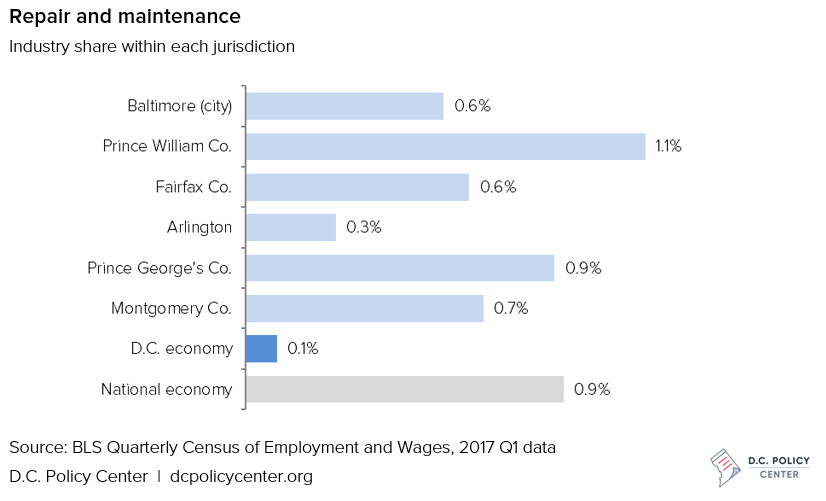

The overwhelming majority of employees nationally classified in this industry work in automotive repairs, and the same is true of D.C. The District’s economy supported only 700 repair and maintenance jobs, with most of those related to automotive work.
(Janitors and many other related professions are classified separately.)
Transportation and warehousing
Location quotient: 0.11
Private sector transportation and warehousing – another one of the largest sectors nationally – encompasses a range of businesses that include trucking companies, airlines and storage facilities. In D.C., the industry remains tiny, employing only about 2,800 private sector workers, with an industry concentration approximately nine times less than the national rate. One caveat here is that these numbers don’t include public sector workers, so Metro employees are excluded. Approximately 1,100 D.C. private sector transit and ground passenger transportation jobs account for much of the District’s employment in the industry. All the tour buses and boats provide another source of employment, amounting to 600 jobs in “scenic and sightseeing” transportation.
While transportation and warehousing is particularly absent in D.C, the sector has a larger role in several surrounding counties. Industry shares are notably higher in the city of Baltimore (4.3 percent), Arlington (4.8 percent) and Prince George’s County (3 percent), compared with less than one-half of a percent of D.C. jobs and 3.4 percent of jobs nationally.
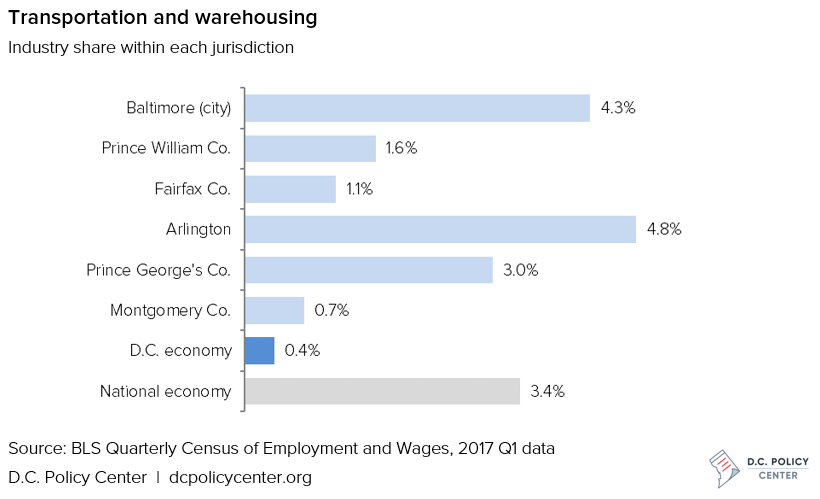

Building material and garden supply stores
Location quotient: 0.15
While the District is home to a few large home improvement stores, there aren’t a whole lot of places to purchase building supplies. The Labor Department’s numbers indicate building material and garden supply stores employed only about 1,000 workers in March, or nearly seven times less than the industry’s share of national economy. One contributing factor has to do with demand: single-family residences aren’t as prevalent here as they are in more suburban areas. Suburban counties in Maryland and Virginia have industry concentrations that more closely mirror the national economy.
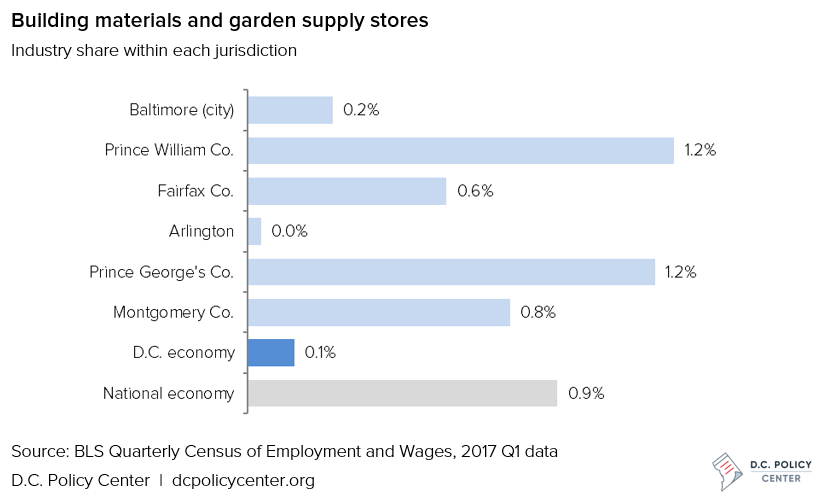

Insurance carriers
Location quotient: 0.20
The D.C. economy supports relatively few jobs in the insurance industry. The Labor Department counted 91 insurance carrier establishments, but most were small, employing just under 1,300 total workers. Insurance carrier employers have also started to shrink somewhat as they had employed roughly 2,000 workers a few years earlier. Direct life and health insurance carriers accounted for most local jobs. Such jobs aren’t particularly prevalent across much the region, with the exception of Montgomery County, Md.
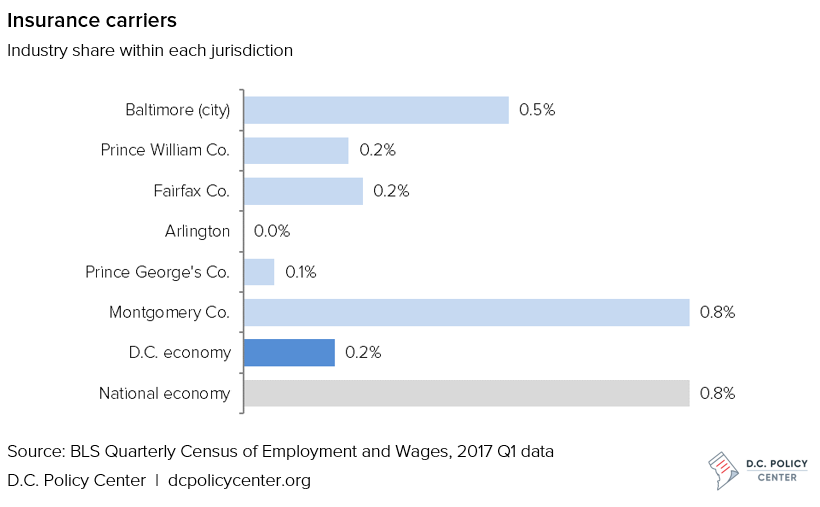

(This category does not include insurance agencies, brokerages and other insurance-related activities.)
Services for older adults and people with disabilities
Location quotient: 0.20
This industry provides various types of nonresidential support and assistance to older adults and people living with disabilities. The fact that it’s relatively small—employing only about 1,800 workers—is largely a function of demographics. The latest Census Bureau estimates suggest the age 75 and over population accounts for only 4.8 percent of the District’s population, lower than all but three states. Common occupations in this category include personal care workers, nurses and home health aides.
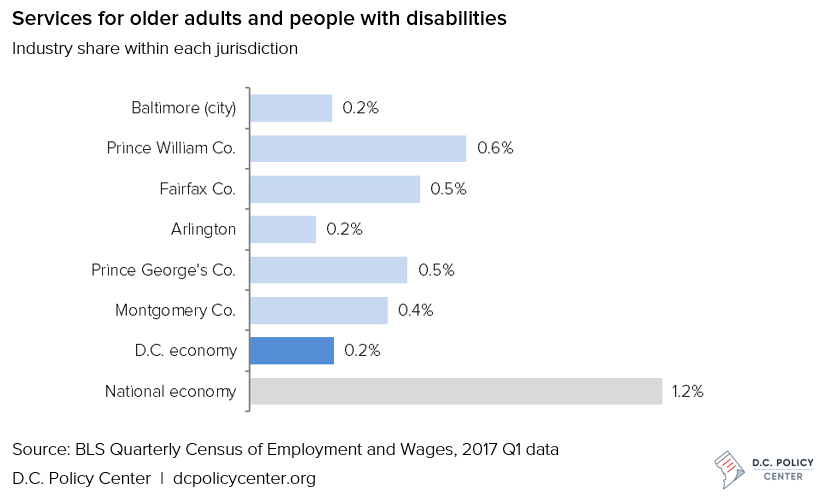

Jobs in services for older adults and people living with disabilities are also relatively low throughout the region. These jobs account for an estimated 1.2 percent of employment nationally, but only about half a percent in Fairfax, Prince George’s, and Prince William counties.
(Continuing care and assisted living facility employment, classified separately, is also significantly underrepresented with a location quotient of 0.21.)
Management of companies and enterprises
Location quotient: 0.21
While quite a few top managers in government work in the District, the same cannot be said of those managing some corporations and holding companies. The industry employs more than 2 million people nationally, but only about 2,600 in D.C. The Labor Department defines the classification as establishments holding the securities of companies “for the purpose of owning a controlling interest or influencing management decisions” or those that “administer, oversee, and manage establishments of the company or enterprise.” (The few such jobs that are in D.C. tend to pay well, with a wage location quotient of 1.31.) Arlington, Fairfax and Montgomery counties are all home to larger concentrations of these jobs than D.C. and other areas.
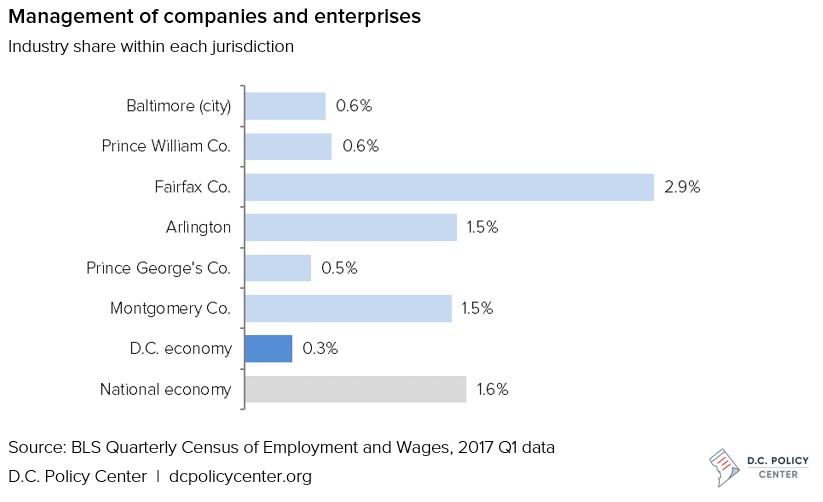

General merchandise stores
Location quotient: 0.21
This category covers a broad group of retail establishments including department stores, dollar stores, supercenters, and warehouse clubs. The industry supports less than 3,400 jobs in the District, with its local concentration about five times smaller than the national economy. While still not very common, these businesses have been expanding their presence in D.C. lately as they had employed less than 2,000 workers in early 2013. Costco and Walmart are among retailers opening large stores in recent years.
General merchandise stores are less common in D.C. than surrounding counties. Prince William County has a particularly high share of these jobs — nearly double the national rate.
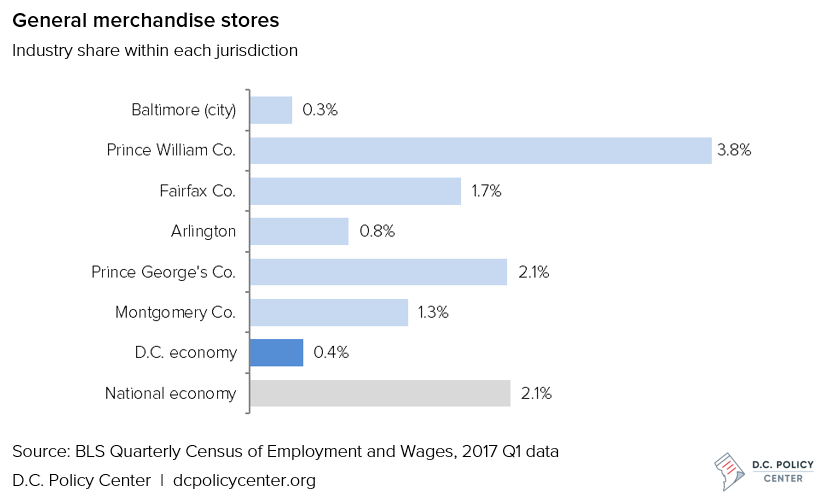

(This category does not include grocery stores, convenience stores and those specializing in one type of product.)
Smaller Industries
Similarly-low industry concentrations exist for smaller segments of the economy. The following industries employing between 500,000-1,000,000 workers nationally are also significantly underrepresented in D.C.’s economy.
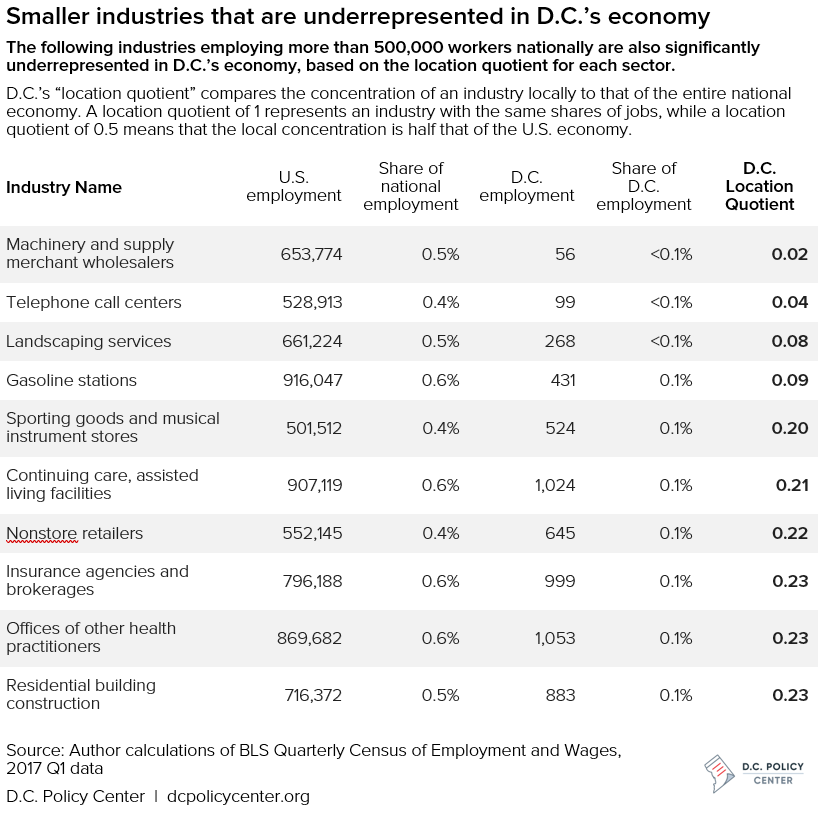
Notes
[1] Location quotients are rounded to the second decimal point.
About the data
Location quotients and job totals were reported in the Labor Department’s Quarterly Census of Employment and Wages data for March 2017. Location quotients are calculated by dividing an industry’s percentage of total jobs in an area by its percentage of jobs in the national economy. Figures shown for all industries only represent private sector jobs. Industries are defined by the North American Industry Classification System (NAICS) using the following industry codes: Building material and garden supply stores (444), general merchandise stores (452), insurance carriers (5241), management of companies and enterprises (55), manufacturing (31-33), motor vehicle and parts dealers (441), repair and maintenance (811), services for the elderly and disabled (62412), transportation and warehousing (48-49).
Feature photo by Ted Eytan (Source)
D.C. Policy Center Fellow Mike Maciag crunches numbers and writes for Governing magazine on a variety of policy issues relating to state and local governments. He holds a master’s degree in public administration from George Mason University and undergraduate degrees in journalism and computer science from the University of Dayton. Follow him on Twitter at @mikemaciag.
